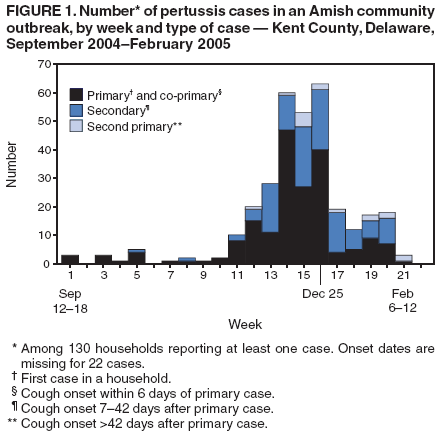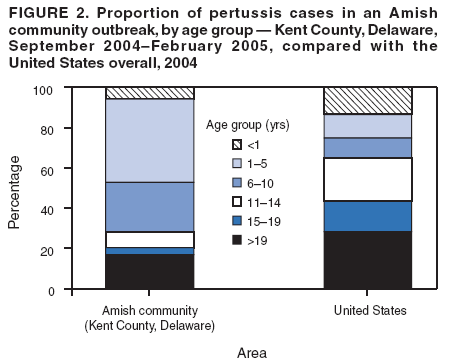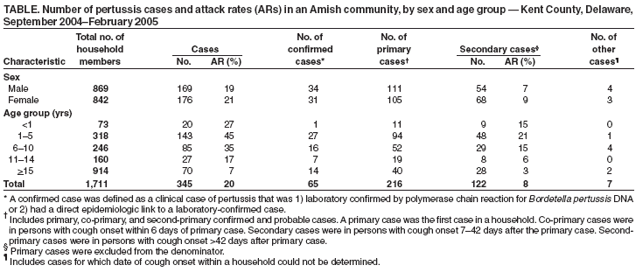 |
|
|
|
|
|
|
| ||||||||||
|
|
|
|
|
|
|
||||
| ||||||||||
|
|
|
|
|
Persons using assistive technology might not be able to fully access information in this file. For assistance, please send e-mail to: mmwrq@cdc.gov. Type 508 Accommodation and the title of the report in the subject line of e-mail. Pertussis Outbreak in an Amish Community --- Kent County, Delaware, September 2004--February 2005Vaccine-preventable disease outbreaks continue to occur among undervaccinated populations in the United States, including contained religious communities (1,2). The Amish practice separation from the world through group solidarity and caring for their own (3). Amish religious doctrine does not prohibit vaccination; however, coverage levels for routine childhood vaccination remain low in many Amish communities (1). This report describes an outbreak of pertussis in an Amish community in Kent County, Delaware, during September 2004--February 2005, that resulted in 345 cases and affected primarily preschool-aged children. The outbreak underscores the need to promote vaccination in Amish communities through culturally appropriate strategies, such as education and outreach to community leaders. For this outbreak, a clinical case was defined as an acute cough illness lasting >2 weeks with onset during September 2004--February 2005 and without other apparent cause in a person living in the Amish community in Kent County (4). A confirmed case was defined as a clinical case of pertussis that 1) was laboratory confirmed by polymerase chain reaction (PCR) for Bordetella pertussis DNA or 2) had a direct epidemiologic link to a laboratory-confirmed case through a common household residence. All other clinical cases were considered probable. During October 2004--December 2004, a total of 12 PCR-confirmed cases of pertussis were reported among Amish residents in a community west of Dover, Delaware. Cases were reported to the Delaware Division of Public Health (DPH) by DPH nurses from Southern Health Services (SHS), the public health clinic serving the two southernmost counties in Delaware. Several SHS nurses had treated pertussis patients previously in this community and had knowledge of the low community vaccination rates; therefore, pertussis was suspected when children with symptoms were reported. Control measures and active surveillance for additional cases were instituted, including enhanced contact investigation and outreach and special community pertussis clinics at Amish schools. The clinics provided an opportunity to distribute erythromycin, where appropriate, under standing orders. In addition, the clinics enabled further education of families regarding pertussis prevention and control measures. To increase awareness of the outbreak among health-care providers, health-alert notices and diagnostic kits were distributed to area physicians. To confirm the outbreak, the Delaware Public Health Laboratory (DPHL) performed PCR for B. pertussis on nasopharyngeal swabs from persons with typical outbreak-associated illness. Of the 49 swabs obtained from persons with cough illness living in the Amish community, 30 (61%) were PCR positive. A certain number of swabs obtained from persons with suspected pertussis were sent to CDC for culture confirmation. B. pertussis was cultured from two of 12 outbreak-associated samples forwarded to CDC,* confirming that B. pertussis was circulating in the community. For comparison, 22 swabs were taken from Delaware residents with cough illness without epidemiologic links to Amish persons. Bordetella parapertussis was isolated from two of the 22 swabs; none of those were culture positive for B. pertussis. To maximize active surveillance and control measures, a door-to-door case finding and contact investigation program was instituted. Standing orders allowed for the distribution of erythromycin for treatment and prophylaxis at households in which symptomatic persons and their contacts were identified. In an additional attempt to identify all symptomatic persons, a self-administered survey regarding recent cough illness was distributed to all Amish families, one per household, through community religious leaders. A household was defined as persons living in a common residence. A 2005 Amish directory published by an Amish community member was used to identify the number of households and the number and ages of household members. As part of the self-administered survey, each respondent was questioned regarding willingness to be interviewed in person by DPH staff. CDC and DPH staff conducted structured interviews at willing households in which a person with a cough illness had been identified through the contact investigation, the door-to-door case-finding program, or the self-administered survey. On the basis of historical knowledge, vaccination coverage in the Amish community was presumed to be low, but it had not been formally investigated before the outbreak. To obtain an estimate of the vaccination coverage of children in the community, the Delaware Immunization Registry was queried for the immunization records of all children aged 6 months--5 years identified in the household interviews. Self-Administered Survey ResultsA total of 323 households and 1,711 Amish community members were listed in the community directory. Of 323 households, 184 (57%) returned the self-administered questionnaire; 195 (19%) of 1,008 persons living in these households had self-reported illness consistent with the clinical case definition for pertussis. Household Interview Survey ResultsInterviews were conducted at 110 of the households in which pertussis cases were suspected. A total of 274 cases of pertussis (65 confirmed, 209 probable) were identified in 96 of the households; no cases of pertussis were identified in 14 of the 110 households. Among the 618 persons residing in the 96 households, 220 (36%) reported taking erythromycin for >5 days, 98 (16%) reported taking the drug for <5 days, and 300 (49%) declined antibiotics or had already passed the exposure window for which antibiotics were indicated. For both patients and contacts, an average of 15 days elapsed from cough onset in the primary case to the date antibiotic therapy was initiated. Among 85 patients who attended school, 51 (60%) missed no school, 18 (21%) missed 1--3 days, seven (8%) missed 4--7 days, and nine (11%) missed >7 days of school. Overall, 47 (12%) of 274 patients reported a history of illness compatible with pertussis before 2004, compared with 189 (55%) of 344 household members who were not ill (odds ratio: 0.17; 95% confidence interval = 0.11--0.25). Thirteen persons (6%) reported 1986 as the specific year of previous pertussis-like illness, 24 (10%) reported 1996, and 70 (30%) reported illness sometime during 1987--2003. Of 123 patients aged 6 months--5 years residing in interviewed households, immunization registry results revealed that 88 (72%) had no records of vaccination with diphtheria-tetanus-pertussis (DTP/DTaP) vaccine, six (5%) had records of receiving 1 or 2 doses, and 29 (24%) had records of receiving >3 doses. For 163 children aged 6 months--5 years without clinical pertussis residing in households with pertussis patients, 106 (65%) had no records of vaccination with DTP/DTaP vaccine, eight (5%) had records of receiving 1 or 2 doses, and 49 (30%) had records of receiving >3 doses. Of the 96 households interviewed in which a pertussis case was discovered, a total of 43 (45%) reported not vaccinating any children in their household, 40 (42%) households reported vaccinating at least some children, and 13 (14%) did not provide this information. Of the 43 households not vaccinating children, 19 cited "fear of side effects" as the reason, 13 reported that they "didn't think about it," and 11 did not provide specific reasons for nonvaccination. Of the 40 respondents who reported that their children had received vaccinations, 29 (64%) reported vaccination at vaccine clinics set up at Amish homes by DPH nurses. Combined Survey ResultsThe combined number of pertussis cases identified from the self-administered survey and the household interview survey was 345, including 65 confirmed and 280 probable cases. The estimated overall attack rate for clinical pertussis was 20% (345 of 1,711). Of the cases identified by combining the self-administered and household interview surveys, 20 (6%) were among infants aged <1 year, 143 (41%) were among children aged 1--5 years, and 182 (53%) were among those aged >5 years (Table). The median age of patients with clinical cases was 6 years (range: 0--75 years). Among all patients with clinical cases, 171 (50%) reported paroxysms of cough, 115 (33%) reported inspiratory whoop, and 108 (31%) reported posttussive emesis. No hospitalizations or deaths were reported. Cough onset occurred from September 12, 2004, to February 12, 2005 (Figure 1). During the same period, seven PCR-positive pertussis cases were reported in Delaware among persons with no epidemiologic link to an Amish person. Reported by: P Eggers, D Austin, L Hathcock, PhD, P Silverman, DrPH, F Ahmed, MBBS, E Outten, M Postell, L Rouse, J Waring, Delaware Div of Public Health. K Kretsinger, MD, C Mijalski, MPH, P Nuorti, MD, P Cassiday, MS, National Center for Immunization and Respiratory Diseases (proposed); K Kudish, DVM, A Cohn, MD, EIS officers, CDC. Editorial Note:Among the diseases for which universal childhood vaccination is recommended in the United States, only pertussis has had an overall increase in reported cases since 1980, increasing from 1,730 cases in 1980 to 25,827 cases in 2004 (5). Rates of reported pertussis in the United States are highest among young infants and adolescents (6,7). In 2004, the incidence of pertussis among persons aged <1 year was 84 per 100,000; among persons aged 1--10 years, 18 per 100,000; among persons aged 11--19 years, 24 per 100,000; and among persons aged >19 years, four per 100,000 (CDC, unpublished data, 2004). Routine childhood immunization, which has been determined to be highly effective (8), includes a 3-dose DTaP series at ages 2, 4, and 6 months, followed by boosters at 18 months and 4--6 years. Adolescents and adults can become susceptible to pertussis because of waning immunity approximately 5--10 years after booster vaccination. In 2005, two new pertussis vaccines (i.e., tetanus toxoid, reduced diphtheria toxoid and acellular pertussis [Tdap] vaccines) were licensed in the United States for use among persons aged 10--18 and 11--64 years, respectively. Routine adolescent and adult Tdap vaccination has been recommended by the Advisory Committee on Immunization Practices.† The age distribution of cases in this outbreak differed from that of the U.S. population. Amish children aged 1--5 years represented 143 (41%) of pertussis cases identified during the outbreak (Figure 2). They also experienced the highest primary and secondary household attack rates (Table). This age distribution is similar to that observed in the prevaccine era in the United States (i.e., before the 1940s) (9) and probably reflects the low pertussis vaccination coverage in the Amish community. Adults and adolescents were largely unaffected by the outbreak, possibly because of previous exposure to B. pertussis. A previous pertussis outbreak occurred in this undervaccinated population in 1986 (10). Members of the community reported having whooping cough not only in 1986 but also in multiple subsequent years, suggesting periodic circulation of B. pertussis within the community. More cases were reported among young children than among infants aged <1 year, which might reflect increased opportunities for exposure resulting from close social interaction of ambulatory children. Outbreak-control measures with demonstrated effectiveness in limiting the spread of pertussis include prompt treatment and postexposure prophylaxis of contacts with antibiotics (4). In this outbreak, the majority of the children were unvaccinated or undervaccinated, and adherence to erythromycin prophylaxis was suboptimal. Outbreaks of vaccine-preventable diseases (VPDs), such as rubella and Haemophilus influenzae type b, have been reported in Amish communities (1,2). Control of VPDs in these communities presents unique challenges, in part because of their isolation. Amish persons typically have lower vaccination coverage and often delay or avoid seeking medical care (1). Since 1980, public health nurses in Delaware have conducted immunization clinics at two fixed outreach sites in Amish homes, but coverage rates have remained low. After the outbreak described in this report, DPH staff distributed educational pamphlets discussing immunization and VPDs, including information about Amish immunization outreach clinics. The reasons cited by persons in Amish households for failure to vaccinate children (e.g., fears of vaccine-related adverse events and general lack of awareness regarding vaccination) were not religious or doctrinal. This suggests that enhanced outreach and education regarding vaccination safety and protective benefits might help increase coverage rates. Acknowledgments This report is based, in part, on the contributions of Southern Health Services, Dover, Delaware; the Delaware Division of Public Health; and the National Immunization Program, CDC. References
* Pertussis is most often diagnosed clinically; no laboratory test exists that is both sensitive and specific. Culture of a nasopharyngeal sample is 100% specific, but relatively insensitive, especially later in the course of the disease and after antibiotic treatment. PCR is often more sensitive, but false positives can occur. In an outbreak setting in which some clinical cases have been confirmed by culture, PCR alone can be used to confirm clinical diagnoses. † Available at http://www.cdc.gov/nip/recs/provisional_recs/default.htm.
Figure 1  Return to top. Figure 2  Return to top. Table  Return to top.
Disclaimer All MMWR HTML versions of articles are electronic conversions from ASCII text into HTML. This conversion may have resulted in character translation or format errors in the HTML version. Users should not rely on this HTML document, but are referred to the electronic PDF version and/or the original MMWR paper copy for the official text, figures, and tables. An original paper copy of this issue can be obtained from the Superintendent of Documents, U.S. Government Printing Office (GPO), Washington, DC 20402-9371; telephone: (202) 512-1800. Contact GPO for current prices. **Questions or messages regarding errors in formatting should be addressed to mmwrq@cdc.gov.Date last reviewed: 8/3/2006 |
|||||||||
|